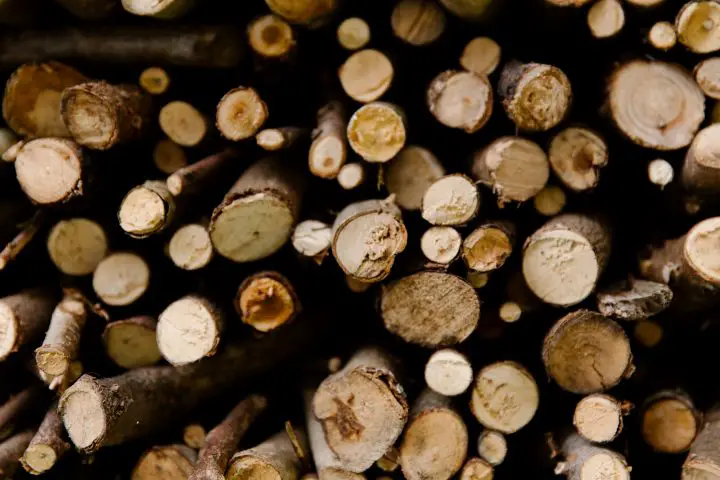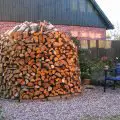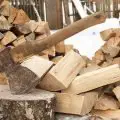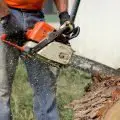Storage is very important when it comes to anything wood-related. If you have a large quantity of wood, no matter what you want to use it for, then you will need to make sure you properly store it.
Firewood, especially, needs to be stored properly; otherwise, it will be almost useless as incorrect storage can leave it too moist to burn. In this article, we’ll provide all the relevant tips and to help you learn how to stack firewood the best way.
Table of Contents
- Are You Using the Right Tools?
- Why Do You Need to Stack Firewood?
- How Do You Season Wood?
- How to Stack Firewood
- FAQs (Frequently Asked Questions)
Are You Using the Right Tools?
Assuming you are cutting your own firewood and are not buying it in bulk from a specialist store, you need to ensure you have the right tools. While you may have a family member’s ax in your shed that you think is sharp enough to help, it really is best to use a chainsaw. Your time will be saved, as will your back and body.
There are different types of chainsaws, each with their own advantages and disadvantages, so if you’re brand new to buying a chainsaw, this should be researched to find which one is better suited to your needs.
The types of chainsaws are as follows:
- Gas
- Electric
- Battery
- Pneumatic
Any of these will do just fine, so long as they have sharp teeth and still turn on. However, it is worth thinking about bar length as an electric chainsaw will typically be shorter than a gas-powered chainsaw. This should be taken into account, and either a longer chainsaw should be bought or you will just have to work a bit harder or choose smaller pieces to cut.
Why Do You Need to Stack Firewood?
You may initially think that you can just throw firewood into a pile and take it from it whenever you need it, but this is far from the truth. Stacking firewood allows for the wood to season. Seasoned wood is what firewood is meant to be, as it is a lot easier to burn and burns for longer.

If you were to carelessly stack wood then that would trap moisture in-between bits of firewood and keep them moist for a long time, making them less useful when you decide to burn some wood.
Unseasoned firewood is a very bad fuel to burn as it has a high moisture content which will smoke when being burnt. This smoke will still hold some natural acids found in wood which will cause damage to your chimney or whatever else the smoke is coming into contact with.
Unseasoned wood also does not burn as well, due to still being damp, and will be counted as a reaction of incomplete combustion if the moisture content is over 20% which will lead to more smoke, worse smells, and a bad flame.
Seasoned firewood with a moisture content of less than 20% is prone to burning way too fast, which will leave you needing more wood to stay warm. Properly seasoned wood has around 20% moisture content and will burn well, with minimal smoke, and stay lit for a decent amount of time.
How Do You Season Wood?
To season wood, you will leave it to naturally dry while ensuring that it has sun exposure and good air circulation that can flow freely. Stacking firewood in an area that has both sun exposure and adequate airflow will result in properly seasoned firewood.
How to Choose a Location
Choosing a location should take both natural elements into account. A desirable location would be one that has proper airflow while still being in the sunlight. Air movement is critical as this is what dries out the wood and helps shed water, so make sure it gets enough air.
Another point to take into consideration is how far it is away from your property. If you are wanting to personally consume this firewood as a way to heat your house, then consider stacking firewood at least 5-ft, ideally 30-ft, away from your property.
This is because pests such as termites and other insects or rodents are bound to try and make a home out of your wood stack. This is completely fine for the wood itself, but keeping them far away from your house or woodshed is going to prevent them from inhabiting said buildings.
How Long Does It Take to Season Firewood?
Seasoning wood can take the better part of a year to finalize. This is because drying wood is a pretty difficult task and takes a long time to dry an entire stack. Wood dries at a steady rate, assuming your storage conditions are correct, but a lot more comes into it than just storage.
The other variables for how quickly your firewood are:
- When the tree was initially cut down
- How the timber was stored before purchase (only applicable if you’re buying)
- Where do you store it?
Assuming everything is either optimal or close to being so, then it can take anywhere between 3-12 months. On average, that is 6 months but is entirely dependent on the weather and how hot it is during this time, or how much the sun is actually exposed. If you want to make sure the seasoning process is complete, then it is best to be patient and not try to use the wood prematurely.
How to Know When Firewood Is Seasoned
Thankfully, there are quite a few ways to tell if firewood is seasoned or not. One of the most natural ways to tell is by looking at the ends of the firewood. If it is dark in color, cracked, and dry to the touch then it has been properly seasoned.
Another way to tell is to knock two pieces together. A hollow sound should follow this, which indicates the firewood is dry and properly seasoned. Dry firewood is a lot lighter in weight than wet firewood and the bark should peel off without much resistance. If your firewood has any green coloring, or the bark is difficult to peel off then it is not yet seasoned.
How to Stack Firewood
Like many things in life, there are multiple methods to get the job done. Many of them have different advantages and disadvantages, or just simply adapt better to the situation you have at hand. Stacking firewood is no different.
The aim of the game is to maximize the airflow surrounding the firewood so that no piece is left without proper air circulation. This can easily be achieved by using odd-shaped pieces of firewood as well as stacking them crossways.
Cross-Stack Your Firewood
When making a wood stack, you want to make sure that your wood is cross stacked so that the airflow is optimized. This consists of using odd-shaped irregularities to offset the rows of wood.
Doing this will ensure that air flows freely in between each row and column as the odd-shaped cuts of wood will make the wood fit together in a more imperfect manner, causing more gaps to appear.
The cross-stacking method not only helps with the airflow but also allows for any natural moisture and water to drain in alternating directions down the pile, ensuring that it ends up being absorbed by the ground.

When making a wood stack, you want to make sure that your wood is cross stacked so that the airflow is optimized. This consists of using odd-shaped irregularities to offset the rows of wood.
Doing this will ensure that air flows freely in between each row and column as the odd-shaped cuts of wood will make the wood fit together in a more imperfect manner, causing more gaps to appear.
The cross-stacking method not only helps with the airflow but also allows for any natural moisture and water to drain in alternating directions down the pile, ensuring that it ends up being absorbed by the ground.
Bark Facing Upwards
It is crucial that you have your firewood with the bark side facing upwards. This is to counter the moisture that may be coming from above, as the bark is less likely to be absorbing moisture compared to the freshly cut sides.
When placed bark side up, any rain that finds its way into your woodpile is going to be less damaging as it will run down the bark until it hits the floor. Any split firewood is likely to have 3 main sides, one that is bark and the two that expose the inner layers of the tree.
The latter two sides are a lot more absorbent than the bark, so it is best to make sure any naturally running water does not seep directly into them and instead trickles down the pile, only making contact with the bark.
Keep Your Firewood Off the Ground
It is criminally overlooked how important it is to keep your firewood off of the ground. The timber will absorb ground moisture if not elevated, which will most likely ruin the first couple of rows. To prevent this, use pressure-treated wood, pallets, or anything else that is sturdy and non-absorbant.
It is crucial that when elevating your firewood stack from the ground, you ensure it is sturdy and keep all kids and pets safe.
Fence-Supported
If you have a fence in your garden, or on your property, then stacking the firewood up against it is an excellent way to store your wood as the fence provides stability and support. When stacking firewood without support, the stack can only be a few feet high as the lack of support does not allow for the stack to not topple over.
Using a fence allows you to stack your firewood a lot higher than usual, meaning you can season more firewood at a time in the same location.
When stacking against a fence, make sure that the freshly cut side is facing away from the fence, and that the bark is facing upwards.
Cover the Top Without Blocking the Sun
Despite the bark facing upwards, rain can still slow your progress by a lot, so it is important to cover your firewood stack with something such as a big enough piece of tarpaulin. When doing so, you want to make sure that you do not cover too much of the side, as ventilation is important, and that you also do not block out the sun.
Tarpaulin is a great way to do this as it is waterproof, so your wood stack does not get wet, yet it is also thin enough that the sun will still help dry and season your wood.
Holz Hausen
The Holz Hausen is a german method of storing firewood that boasts impressive efficiency in drying and storage without taking up too much space. The Holz Hausen method also requires no rack or exterior support as it is entirely self-supporting.
If you want to use the Holz Hausen method for stacking firewood, then you will be pleasantly surprised by how easy it is. This method of stacking wood also requires minimal tools or preparation.
What Will You Need?
All you will need for this is a stake that reaches around 7-8 ft tall, a spacious area away from your property, and a lot of firewood.
As mentioned previously, stacked firewood should be placed ideally 30 ft away from any property, as firewood stacks attract bugs and termites, which are not nice to have in the home.
How to Build a Holz Hausen
Start by driving your stake a foot deep into the ground. This will help mark the center of your Holz Hausen. Measure 5 and one half up from ground level and mark your stake at that level.
After this, start to lay your firewood around the stake with approximately one-foot width between the stake and your firewood. Assuming the firewood is roughly shaped like a long pyramid, you want to place the point facing towards the center. This will mean you have the larger and wider side of the firewood facing outwards.
Using a tape measure, or even a stick, go along the bottom layer and place each piece until the circle is complete. The pieces used here will want to be more controlled and neat however, the beauty of the Holz Hausen is that even the weird and ugly pieces are eventually used. So don’t throw them away!
After the lower layer is finished and is now a complete circle, you will want to start placing your firewood in the same manner but lengthways. With the thinner halves being on the inside, you will now want to continue stacking your firewood until you start to form a sturdy base.
If you notice that the angle of some pieces is starting to look off, readjust them by using thinner or thicker pieces. It is best to catch this early so it does not become a bigger issue.
A Holz Hausen is typically stacked to about 6-7 feet tall so when you reach the marking on your stake, it is time to change the method of how you stack the rest of your firewood.
Before building a roof for this, make sure to throw any loose bits of split wood or firewood inside the Holz Hausen, they will still season properly and will also help add support to the structure.
To make the roof of the structure, continue building as normal but reverse your technique. Place the firewood with the thinner bits on the outside with the thicker bits on the inside. This will create a slope forming in the opposite direction to the rest of your Holz Hausen.
Once your roof reaches a natural point, it can be covered with bark or any other covering to prevent moisture. If using a sheet of tarpaulin, make sure it is tied down so that it does not fall off due to prevailing winds. Covering the top layer of your Holz Hausen will help with the seasoning process as less moisture will find its way in. Learn more here.
As you can tell, stacking firewood is essential to the process of seasoning and acquiring proper firewood that burns completely and safely. While there is no best way to stack firewood, hopefully, one of these methods will help you out as they are all tried and tested. With all of this knowledge, you should now be able to stack your firewood and prevent moisture efficiently and easily.
Firewood-related pages:
FAQs (Frequently Asked Questions)
What is the best way to stack firewood?
Place the wood in a single row, away from the sun, with enough space between each piece to permit airflow. As a result, the wood is exposed to more air and sunlight, allowing it to dry out more quickly. For stability when stacking, create pillars in the shape of a cross at each end.
Do you stack firewood bark up or down?
The trick is to place the rounded, bark-covered side toward the sky (or, if stacking in a covered woodshed, the bark-side below). The exterior will aid in water drainage, while the exposed wood below will continue to breathe and release moisture into the atmosphere.
Is it OK to stack firewood on the ground?
Putting firewood in a pile on the ground is not a smart idea. Termites are drawn to wood, and moisture from the ground can seep through and keep the wood from drying out. Instead, use one of the above-mentioned stacking techniques to lift it off the ground for storage.
How do you stack split firewood?
Place the split firewood in a single row, away from the sun, with enough space between each piece to permit airflow. As a result, the wood is exposed to more air and sunlight, allowing it to dry out more quickly. For stability when stacking, create pillars in the shape of a cross at each end.





